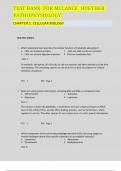Exam (elaborations)
TEST BANK FOR MCCANCE HUETHER PATHOPHYSIOLOGY ALL CHAPTERS WITH CORRECT ANSWERS 2024
- Institution
- Chamberlain College Of Nursing
- Book
- Pathophysiology
TEST BANK FOR MCCANCE HUETHER PATHOPHYSIOLOGY CHAPTER 1: CELLULAR BIOLOGY MULTIPLE CHOICE 1. Which statement best describes the cellular function of metabolic absorption? a. Cells can produce proteins. c. Cells can take in and use nutrients. b. Cells can secrete digestive enzymes. d. C...
[Show more]



